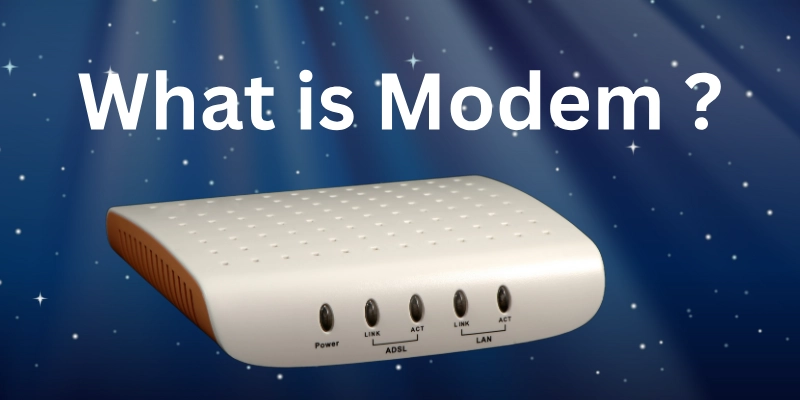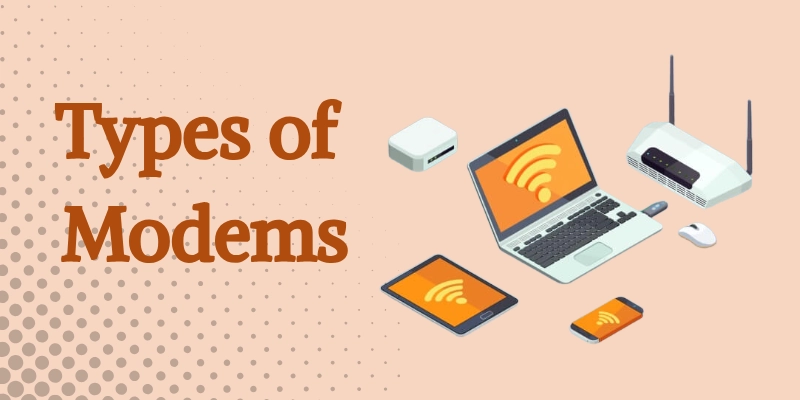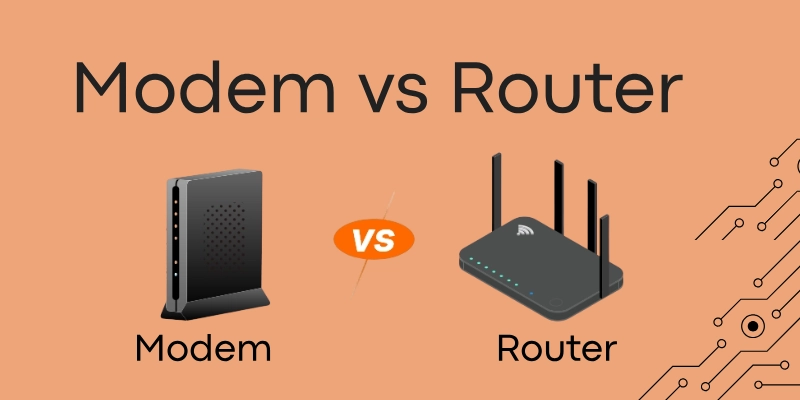What is a Modem and How Does It Work
Published: 1 Sep 2025
In the world of computer networks, the modem plays a vital role in connecting us to the Internet. The word modem is short for Modulator–Demodulator, which refers to its ability to convert digital signals from your computer into analog signals for transmission, and vice versa. Without a modem, most devices would not be able to communicate effectively with an Internet Service Provider (ISP).
Whether you are browsing websites, streaming videos, or playing online games, a modem is the gateway device that bridges the gap between your digital devices and the wider Internet.

In this article, we’ll explore what a modem is, how does it work, types of modems, and the difference between a modem and a router, while also answering common questions people have about this essential device.
What is a Modem in Computer Networks?
A modem in computer networks is a hardware device that enables computers and other devices to send and receive data over the Internet. It essentially acts as a translator:
- Computers work with digital data (0s and 1s).
- Telephone and cable lines often carry analog signals.
- The modem modulates (converts digital to analog) when sending data.
- It demodulates (converts analog back to digital) when receiving data.
This modulation-demodulation process allows smooth communication between your computer and the ISP, making it possible to access the Internet.
How Does a Modem Work?
The working principle of a modem is simple yet powerful. Let’s break it down step by step:
- When you request a website or send data online, your computer generates digital signals.
- The modem modulates these digital signals into analog signals suitable for transmission over telephone, coaxial, or fiber-optic cables.
- These signals travel through your ISP’s infrastructure until they reach the Internet backbone.
- When data comes back from the Internet, the modem demodulates analog signals into digital signals that your computer can understand.
Example in Daily Life
Think of a modem like a language translator. If two people speak different languages, they need a translator to communicate. Similarly, the modem ensures your computer “speaks the same language” as the Internet connection.
Speeds: Past vs Present
- Early modems (dial-up) worked at speeds of 110–300 bps and required phone lines.
- Modern modems (fiber, cable) can support speeds of hundreds of Mbps or even Gigabits per second.

Types of Modems
When people search for “modem and types of modem”, they are usually looking for detailed classifications. Here are the main types:
Dial-Up Modem
Dial-up modems were the earliest devices that allowed computers to connect to the Internet using traditional telephone lines. They convert digital signals into sound tones that travel over phone networks. Although extremely slow, they marked the beginning of home Internet access.
- Works over telephone lines
- Extremely slow (56 Kbps maximum)
- Rarely used today
Best Use Case: Suitable only for historical reference or areas with no modern infrastructure.
2. DSL Modem (Digital Subscriber Line)
DSL modems became popular as a faster alternative to dial-up, offering Internet access without interrupting phone calls. They still rely on copper telephone lines but deliver much better performance. With variations like ADSL, SDSL, and VDSL, DSL technology has served millions of households worldwide.
- Uses phone lines but allows Internet and voice calls simultaneously
- Faster than dial-up; speeds vary from a few Mbps to 100+ Mbps
- Variants: ADSL, SDSL, VDSL
Best Use Case: Ideal for budget-friendly home Internet with moderate speed needs.
3. Cable Modem
Cable modems use the same coaxial cables as cable television, making them widely available in urban and suburban areas. They are known for offering higher speeds suitable for gaming, video streaming, and heavy browsing. Even today, they remain one of the most common broadband solutions.
- Uses coaxial TV cables
- High speed and widely used
- Supports streaming, gaming, and multiple devices
Best Use Case: Perfect for households with multiple users and heavy Internet usage.
4. Fiber-Optic Modem
Fiber-optic modems use advanced technology that transmits data using light signals over fiber cables. This provides extremely fast and stable Internet connections with minimal interference. They are considered the future of connectivity and are rapidly expanding in many regions.
- Uses fiber cables and light signals
- Extremely high speeds (up to 1 Gbps+)
- Future-proof and increasingly popular
Best Use Case: Best for ultra-fast Internet, streaming in 4K, and future-ready homes.
5. Satellite Modem
Satellite modems are designed for people in rural or remote locations where traditional wired Internet isn’t possible. They communicate directly with satellites orbiting Earth to deliver Internet access. While effective for coverage, they often face high latency due to long signal distances.
- Connects to satellites for remote areas
- Useful where cable or fiber isn’t available
- Higher latency due to long signal travel distance
Best Use Case: Ideal for remote or rural areas with no wired broadband options.
6. VoIP Modem (E-MTA)
VoIP modems, also called E-MTAs, are special devices that combine Internet and telephone services into one unit. They are commonly provided by ISPs to support bundled home packages. This makes them convenient for households that rely on both Internet and voice communication.
- Supports both Internet and telephone services
- Common in households with bundled services
Best Use Case: Great for families or offices that need Internet plus telephone in one device.
7. Softmodem (Software Modem)
Soft modems differ from traditional hardware modems because they rely heavily on the computer’s CPU to process data. This makes them cheaper to produce but less powerful and slower than dedicated hardware modems. They are less common today but were once widely used in budget systems.
- Relies on the computer’s CPU instead of hardware chips
- Cheaper but less efficient
Best Use Case: Suitable for low-cost computing environments with minimal Internet needs.

Modem vs Router: What’s the Difference?
Many people confuse modems with routers, but they perform different tasks:
- Modem: Connect your home network to the ISP. It brings Internet access into your home.
- Router: Distributes that Internet connection to multiple devices, often wirelessly.
Example:
If you connect only one computer directly to the Internet, a modem is enough. But if you want Wi-Fi for phones, laptops, and smart devices, you need a router. Some devices combine both functions into a modem-router combo.
Advantages and Disadvantages of Modems
Like every networking device, modems come with their own set of pros and cons. Below are the key advantages and disadvantages of using a modem. Understanding both sides will help you make a better decision when choosing the right modem for your needs.
Advantages
Modems play a vital role in modern communication, offering several benefits that make Internet access faster and more convenient. Some of the key advantages include
- Essential for Internet connectivity.
- Multiple options: DSL, cable, fiber, satellite.
- High-speed access available with cable and fiber.
- DSL allows simultaneous Internet and phone calls.
Disadvantages
Despite their importance, modems also come with certain drawbacks that can affect performance and user experience. Some of the main disadvantages are
- Dial-up is outdated and extremely slow.
- DSL speeds drop with distance from the ISP.
- Cable modems may slow down during peak hours.
- Modems usually have limited security features (router required).
- Softmodems consume CPU resources.
How to Choose the Right Modem
When searching “what is modem in a computer network” or “modem working principle”, many users also want buying advice. Here are key factors:
- ISP Compatibility – Always check if your modem works with your ISP.
- Speed Requirements – Choose DOCSIS 3.0/3.1 (for cable) or VDSL/fiber-ready for high speeds.
- Number of Ports – More LAN ports give flexibility.
- VoIP Support – Needed if you want phone + Internet service.
- External vs Internal – External modems are easier to manage.
- Future-Proofing – Consider fiber-ready or next-gen DOCSIS standards.
How to Set Up a Modem
Setting up a modem is simple:
- Connect the line – Attach the incoming Internet line (phone, coax, or fiber) to the modem.
- Connect to a device – Use an Ethernet cable to connect the modem to a computer or router.
- Power on – Plug in the modem and wait for indicator lights (Internet, DSL, LAN).
- Configure settings – Some ISPs require login or activation.
- Secure it – Change default admin password and update firmware.
Do Modems Provide Wi-Fi?
By default, most modems do not provide Wi-Fi. However, many ISPs provide modem-router combo devices that include built-in Wi-Fi.
- Pros: Single device, easy setup, saves space.
- Cons: Harder to upgrade, less customizable than separate devices.
If you want flexibility, consider buying a separate high-quality router.
Conclusion
A modem is the backbone of Internet connectivity, translating signals so your devices can communicate with the wider world. From early dial-up devices to today’s high-speed fiber-optic modems, technology has evolved dramatically. When choosing a modem, consider your ISP, speed requirements, and future needs. Whether you use a standalone modem or a modem-router combo, setting it up securely ensures smooth and safe Internet access.
In short, if you’ve ever asked, “What is a modem and how does it work?” it is the device that makes your Internet possible.
We’d love to hear your thoughts! Share your experiences with different types of modems in the comments below and let us know which one you prefer.
FAQs About Modems
Here are some frequently asked questions (FAQs) about modems to help you better understand their functions, types, and importance in computer networks.
Modem stands for Modulator–Demodulator. It converts digital signals from your computer into analog signals for transmission and then back into digital form for communication. Without this conversion, devices would not be able to send or receive data over telephone or cable lines.
A modem connects you directly to the Internet by communicating with your Internet Service Provider (ISP). A router, on the other hand, distributes that connection to multiple devices at once, usually through Wi-Fi. In most homes, both are used together for complete networking.
Yes, a modem can work on its own, but it will only connect one device directly to the Internet. To share the connection across multiple devices, a router is needed. Using both ensures better coverage, security, and convenience.
Cable and fiber-optic modems are considered best for gaming because they deliver higher speeds and lower latency. Unlike DSL or satellite, these options provide stable performance even during peak hours. This results in smoother online gameplay and faster response times.
The primary functions of a modem are signal conversion, Internet connectivity, and communication with the ISP. It acts as a bridge between your home devices and the wider Internet. Without a modem, digital devices cannot exchange data with online networks.
No, not all modems have Wi-Fi capability. Standard modems connect to your device via cables, while only modem-router combo units provide wireless connectivity. For most users, pairing a modem with a separate router ensures better flexibility and coverage.
In computer networks, a modem is the device that enables Internet access by converting digital data into analog signals and vice versa. This process ensures that computers, smartphones, and other devices can communicate with external servers. It is a key component of networking infrastructure.
A modem works by modulating outgoing digital signals into analog form and demodulating incoming analog signals back into digital form. This allows devices to transmit and receive information over communication lines like phone, cable, or fiber. Without this process, Internet communication wouldn’t be possible.
The main types include dial-up, DSL, cable, fiber-optic, satellite, VoIP, and softmodems. Each type differs in speed, technology, and usage scenario. For example, fiber is ultra-fast, while satellite is useful in remote areas where cables can’t reach.
Renting a modem from your ISP is convenient and ensures compatibility, but it usually comes with a monthly fee. Buying your own modem can save money in the long run and gives you more control over speed and features. The choice depends on your budget and needs.

- Be Respectful
- Stay Relevant
- Stay Positive
- True Feedback
- Encourage Discussion
- Avoid Spamming
- No Fake News
- Don't Copy-Paste
- No Personal Attacks

- Be Respectful
- Stay Relevant
- Stay Positive
- True Feedback
- Encourage Discussion
- Avoid Spamming
- No Fake News
- Don't Copy-Paste
- No Personal Attacks





